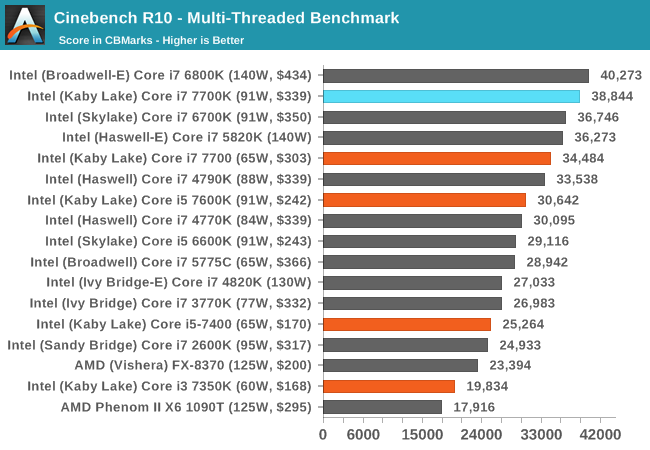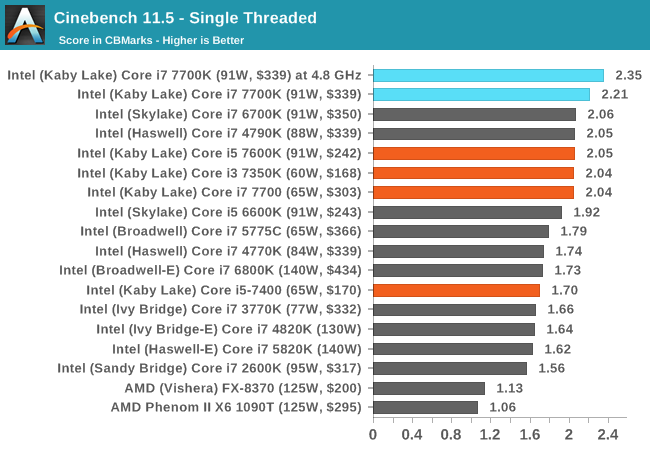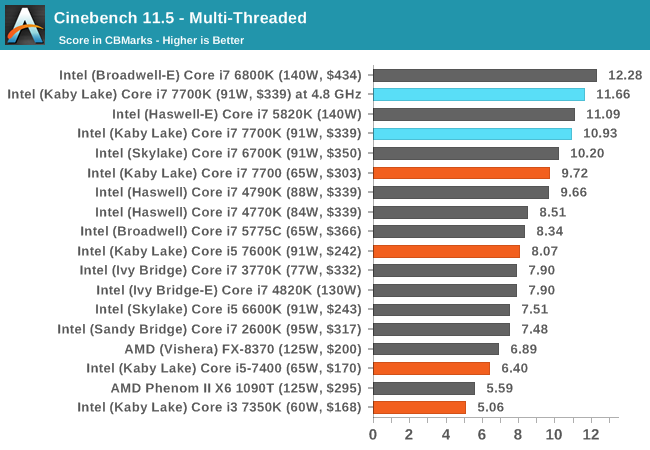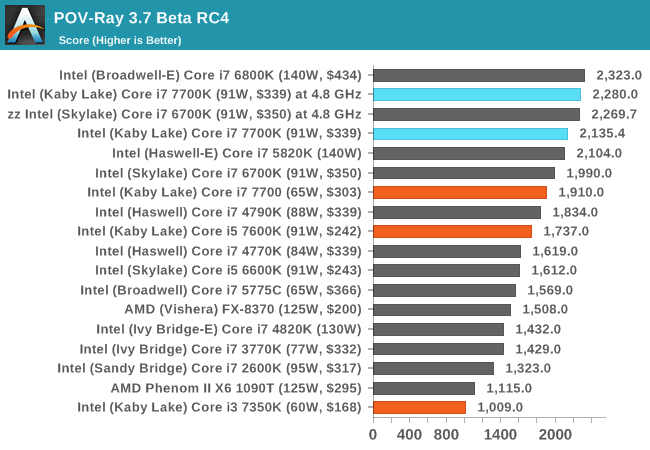The Intel Core i7-7700K (91W) Review: The New Out-of-the-box Performance Champion
by Ian Cutress on January 3, 2017 12:02 PM ESTLegacy Tests
At AnandTech, I’ve taken somewhat of a dim view to pure synthetic tests, as they fail to be relatable. Nonetheless, our benchmark database spans to a time when that is all we had! We take a few of these tests for a pin with the latest hardware.
Cinebench R10
The R10 version of Cinebench is one of our oldest benchmarks, with data going back more than a few generations. The benchmark is similar to that of the newest R15 version, albeit with a simpler render target and a different strategy for multithreading.

For a few years I was under the impression that CineBench’s workload was not amenable to more IPC increases, as we hovered around 7000 pts with new microarchitectures not making much of a difference. Being high frequency the i7-7700K pulls out a lead here, but it’s worth noting that Kaby Lake as a whole scores well, perhaps indicating that other features (such as frequency speed changing) can help.

The multithreaded test gives different results, as this test typically prefers many cores. Rather than the new Cinebench tests dividing the scene up into over a hundred pieces (depends on threads), CB10 purely divides the scene into exactly how many threads are present. If a thread finishes early, it will try and cut the work of another thread in half. This sort of approach to multithreading has a different approach to frequency, cores and IPC, hence why R11.5 and R15 do bigger separations with core workloads.
Cinebench R11.5
CB11.5 has been popular for many years as a performance test, using easy to read and compare numbers that aren’t in the 1000s. We run the benchmark in an automated fashion three times in single-thread and multi-thread mode and take the average of the results.


Similar to other tests, the i7-7700K takes the single thread crown, again beating an overclocked Devil’s Canyon i7-4790K, showing the out-of-the-box performance. Again, Kaby Lake as a whole seems to do well here, thanks to 4.2 GHz turbo modes on the i5-7600K and i3-7350K.
7-zip
As an open source compression/decompression tool, 7-zip is easy to test and features a built-in benchmark to measure performance. As a utility, similar to WinRAR, high thread counts, frequency and UPC typically win the day here.

The Core i7-7700K shows the benefits of frequency over a stock i7-6700K, however at the same frequency they perform roughly the same as expected.
POV-Ray
Ray-tracing is a typical multithreaded test, with each ray being a potential thread in its own right ensuring that a workload can scale in complexity easily. This lends itself to cores, frequency and IPC: the more, the better.

AES via TrueCrypt
Despite TrueCrypt no longer being maintained, the final version incorporates a good test to measure different encryption methodologies as well as encryption combinations. When TrueCrypt was in full swing, the introduction of AES accelerated hardware dialed the performance up a notch, however most of the processors (save the Pentiums/Celerons) now support this and get good speed. The built-in TrueCrypt test does a mass encryption on in-memory data, giving results in GB/s.

The encryption benchmark loves both threads and memory bandwidth, so we see the extreme processors pull out large leads due to 6+ cores and four memory channels. However, we see a similar picture as before to the Devil’s Canyon part: an out-of-the-box Core i7-7700K will beat an overclocked Core i7-4790K at 4.7 GHz.










125 Comments
View All Comments
Michael Bay - Saturday, January 14, 2017 - link
Doom is not very CPU-intensive, and Battlefield is just drek.cpy - Wednesday, January 4, 2017 - link
OMG AVX offset? What took them so long! I need AVX offset for my 4770K! That thing really mess with my OC. It feels like everytime AVX is used i need +0.1V to CPU.thekdub - Wednesday, January 4, 2017 - link
Why is the 4790K "highly overclocked" in these benchmarks, while everything else appears to be running at stock speeds? I was hoping to get some insight as to where my stock 4790K stacks against this new chip as I'm on the fence about upgrading this year or waiting another generation. Instead, I'm stuck making inferences and trying to guess the difference in speed between a known variable and a vague statement of "highly overclocked".Achaios - Wednesday, January 4, 2017 - link
@OP: It is a mistake that you did not explicitly state the OC of the chips you compared.The only thing I am interested right now is the release pf the 1080TI, so please ANANDTECH do your best to bring us some news (preview) regarding.
CPU releases are completely uninteresting and by-and-large meaningless to anyone on a K Sandy Bridge CPU.
I am on a Haswell, and don't see myself upgrading before 2020. Conversely, up to 2020, I would have upgraded my GPU twice.
Achaios - Wednesday, January 4, 2017 - link
"by-and-large meaningless to anyone on a K Sandy Bridge CPU OR LATER". Please consider adding an EDIT function too. :-)just4U - Wednesday, January 4, 2017 - link
Yeah.. there isn't really much of a jump is there? Buying a 7700K for people already on High End I7's made in the past few years is more about ... just wanting something newer, with maybe taking advantage of what some of the newest MBs offer.. I think anyway. Speed? Pfft... you already got that..Now if they released a mainstream I7 that had 6 cores/12 threads in the same package, well then.. that might be something of a different story. (..shrug) intels loss.
Badelhas - Wednesday, January 4, 2017 - link
"Given that Intel has no competition, it is perhaps easy to roll out a new mainstream performance champion".This frase sums it up. And this is why I still own a SandyBridge i5 2500K overclocked to 4.4Ghz (a 33% increase) and find no need to upgrade. Intel is not even trying. It´s just SAD.
Thatguy97 - Wednesday, January 4, 2017 - link
When ivy bridge came out I saw this comingwillis936 - Wednesday, January 4, 2017 - link
Wow I can't believe it: an entire generation of CPUs that change absolutely nothing about the microarchitecture design or transistor size. Why even bother rolling out new SKUs?willis936 - Wednesday, January 4, 2017 - link
This would have been the perfect generation to add eDRAM to the K series. If only AMD would put out.